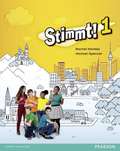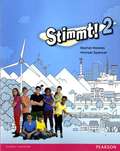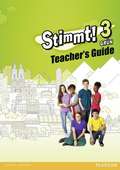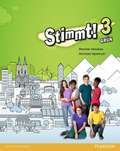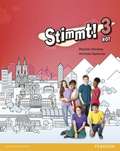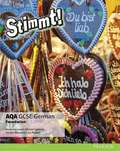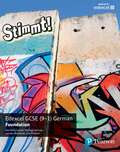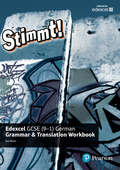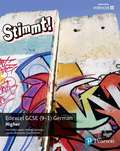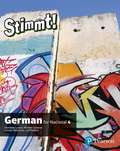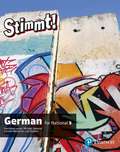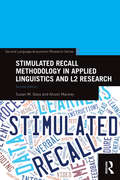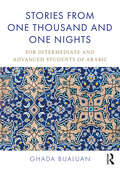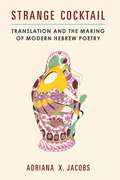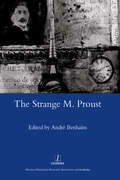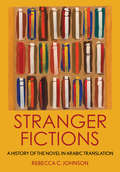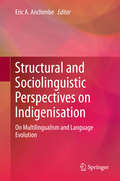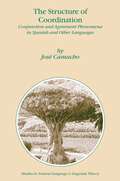- Table View
- List View
Stimmt! 1 (PDF)
by Rachel Hawkes Michael SpencerStimmt! is a new fully-differentiated Key Stage 3 German course packed with content pupils will enjoy learning and which opens the window to the German-speaking world.
Stimmt! 2 Pupil Book: 2 (PDF)
by Michael Spencer'Stimmt!' is a fully-differentiated Key Stage 3 German course packed with content pupils will enjoy learning and which opens the window to the German-speaking world. With a strong focus on developing language learning skills, it encourages students to manipulate language independently, helping to prepare them for KS4 and beyond.
Stimmt! 3 Grun: Teacher Guide (PDF)
by Pearson Firm StaffOur printed Teacher's Guides provide you with complete support to plan and deliver lessons and include a Scheme of Work.
Stimmt! 3 Grun Pupil Book (PDF)
by Rachel HawkesStimmt! 3 is split into parallel differentiated Pupil Books - Grün and Rot to ensure the resources are at the right level for the whole ability range. Packed with topics that your pupils will enjoy learning plus lots of insight into the German-speaking world. A tried-and-tested approach to progression. Build skills to facilitate progression to Key Stage 4.
Stimmt! 3 Rot Pupil Book 3 (PDF)
by Rachel HawkesStimmt 3 is split into parallel differentiated Pupil Books - Rouge Pupil Books stretch learning and contain more self-directed activities. * Covers NC levels 3-7. * Packed with topics yours pupils will enjoy learning, plus lots of insight into the German-speaking world. * A tried and tested approach to progression. * Support for the introduction of phonics to help develop independent speaking and reading skills from the start. * Build skills to facilitate progression to Key Stage 4.
Stimmt! AQA GCSE German Foundation Student Book (PDF)
by Harriette Lanzer Michael Spencer Carolyn Batstone Lisa ProbertExpertly structured Student Book for AQA GCSE German (foundation tier) for first teaching from 2016. Designed to help learners use language independently and to the best of their ability, with fresh and engaging content from the target language culture. Designed for the new AQA GCSE German qualification (foundation tier). A carefully designed programme of learning teaches the 'building blocks' of grammar and vocabulary. Includes popular topics, authentic material and real life-contexts; all with links to the German culture. Each unit and module is structured to allow gradual progression. Exam preparation units are included for Reading, Writing, Speaking and Listening. Revision forms the final module.
Stimmt! Edexcel GCSE German Foundation Student Book (PDF)
by Harriette Lanzer Michael Spencer Carolyn Batstone Lisa ProbertExpertly structured Student Book for Edexcel GCSE (9-1) German (foundation tier). Designed to help learners use language independently and to the best of their ability, with fresh and engaging content from the target language culture. Suitable for the new Edexcel GCSE (9-1) German qualification (foundation tier). A carefully designed programme of learning teaches the 'building blocks' of German grammar and vocabulary. Includes popular topics, authentic material and real life-contexts; all with links to the German culture. Each unit and module is structured to allow gradual progression. Exam preparation units are included for Reading, Writing, Speaking and Listening. Revision forms the final module.
Stimmt! Edexcel GCSE German Grammar And Translation (PDF)
by Jon MeierA dedicated workbook to support and consolidate grammar learning and translation skills for Edexcel GCSE (9-1) German. Includes: explanations of key grammar points, verb tables, and exercises to embed grammar knowledge translation exercises and strategies for translation both into German and into English a bank of revision translations bringing together grammar and vocabulary learning from throughout the course clear links to the Stimmt! Student Books from the same series.
Stimmt! Edexcel GCSE German Grammar and Translation Workbook (Stimmt! Edexcel GCSE German)
by Mr Jon MeierA dedicated workbook to support and consolidate grammar learning and translation skills for Edexcel GCSE (9-1) German. Includes: explanations of key grammar points, verb tables, and exercises to embed grammar knowledge translation exercises and strategies for translation both into German and into English a bank of revision translations bringing together grammar and vocabulary learning from throughout the course clear links to the Stimmt! Student Books from the same series.
Stimmt! Edexcel Gcse German Higher (PDF)
by Harriette Lanzer Michael Spencer Carolyn Batstone Lisa ProbertExpertly structured Student Book for Edexcel GCSE (9-1) German (higher tier). Designed to help learners use language independently and to the best of their ability, with fresh and engaging content from the target language culture. Suitable for the new Edexcel GCSE (9-1) German qualification (higher tier). A carefully designed programme of learning teaches the 'building blocks' of German grammar and vocabulary. Includes popular topics, authentic material and real life-contexts; all with links to the German culture. Each unit and module is structured to allow gradual progression. Exam preparation units are included for Reading, Writing, Speaking and Listening. Revision forms the final module.
Stimmt! German for National 4 (PDF)
by Harriette Lanzer Michael Spencer Carolyn Batstone Lisa ProbertStimmt! for National 4 is an expertly developed course, which will help students achieve their potential in German National 4. The course develops listening, speaking, reading and writing skills and includes a focus on skills such as translation, understanding authentic and literary texts and spontaneous speaking. Cultural content and a focus on ‘learning something new’ help to give students a sense of purpose and bring language learning to life. A ‘building-blocks’ approach in which language and grammar are introduced and recycled helps students use language independently across contexts.
Stimmt! German for National 5 (PDF)
by Harriette Lanzer Michael Spencer Carolyn Batstone Lisa ProbertStimmt! for National 5 is an expertly developed course, which will help students achieve their potential in German National 5. The course develops listening, speaking, reading and writing skills and includes a focus on skills such as translation, understanding authentic and literary texts and spontaneous speaking. Cultural content and a focus on ‘learning something new’ help to give students a sense of purpose and bring language learning to life. A ‘building-blocks’ approach in which language and grammar are introduced and recycled helps students use language independently across contexts.
Stimulated Recall Methodology in Applied Linguistics and L2 Research (Second Language Acquisition Research Series)
by Susan M. Gass Alison MackeyStimulated Recall Methodology in Applied Linguistics and L2 Research provides researchers and students in second language acquisition and applied linguistics with the only how-to guide on using stimulated recalls in their research practice. This new edition expands on the scope of the previous edition, walking readers step-by-step through a range of studies in applied linguistics in order to demonstrate the history of stimulated recalls and their efficacy as a data collection tool. With its exclusive focus on stimulated recalls, coverage of the most up-to-date research studies, and pedagogically rich text design, Stimulated Recall Methodology in Applied Linguistics and L2 Research supplies researchers and students with the practical skills to elicit richer data in their own research.
Stimulated Recall Methodology in Applied Linguistics and L2 Research (Second Language Acquisition Research Series)
by Susan M. Gass Alison MackeyStimulated Recall Methodology in Applied Linguistics and L2 Research provides researchers and students in second language acquisition and applied linguistics with the only how-to guide on using stimulated recalls in their research practice. This new edition expands on the scope of the previous edition, walking readers step-by-step through a range of studies in applied linguistics in order to demonstrate the history of stimulated recalls and their efficacy as a data collection tool. With its exclusive focus on stimulated recalls, coverage of the most up-to-date research studies, and pedagogically rich text design, Stimulated Recall Methodology in Applied Linguistics and L2 Research supplies researchers and students with the practical skills to elicit richer data in their own research.
Stories from One Thousand and One Nights: For Intermediate and Advanced Students of Arabic
by Ghada BualuanSpecially designed for students of Arabic, this textbook presents a selection of authentic Arabian Night stories in simplified language providing learners of Modern Standard Arabic access to this classic of Arabic literature. Each story is fully supported by a range of comprehension, vocabulary-building, grammar reinforcement activities and exercises as well as an audio version of the story, which can be accessed at www.routledge.com/9781138948228. Ideal for class-use or self-study, students will enhance their reading, listening, and writing skills while developing the ability to analyze literary texts, reason critically, and broaden their understanding and appreciation of different layers of Arab culture.
Stories from One Thousand and One Nights: For Intermediate and Advanced Students of Arabic
by Ghada BualuanSpecially designed for students of Arabic, this textbook presents a selection of authentic Arabian Night stories in simplified language providing learners of Modern Standard Arabic access to this classic of Arabic literature. Each story is fully supported by a range of comprehension, vocabulary-building, grammar reinforcement activities and exercises as well as an audio version of the story, which can be accessed at www.routledge.com/9781138948228. Ideal for class-use or self-study, students will enhance their reading, listening, and writing skills while developing the ability to analyze literary texts, reason critically, and broaden their understanding and appreciation of different layers of Arab culture.
Strange Cocktail: Translation and the Making of Modern Hebrew Poetry (Michigan Studies In Comparative Jewish Cultures)
by Adriana X. JacobsFor centuries, poets have turned to translation for creative inspiration. Through and in translation, poets have introduced new poetic styles, languages, and forms into their own writing, sometimes changing the course of literary history in the process. Strange Cocktail is the first comprehensive study of this phenomenon in modern Hebrew literature of the late nineteenth century to the present day. Its chapters on Esther Raab, Leah Goldberg, Avot Yeshurun, and Harold Schimmel offer close readings that examine the distinct poetics of translation that emerge from reciprocal practices of writing and translating. Working in a minor literary vernacular, the translation strategies that these poets employed allowed them to create and participate in transnational and multilingual poetic networks. Strange Cocktail thereby advances a comparative and multilingual reframing of modern Hebrew literature that considers how canons change and are undone when translation occupies a central position—how lines of influence and affiliation are redrawn and literary historiographies are revised when the work of translation occupies the same status as an original text, when translating and writing go hand in hand.
The Strange M. Proust
by Andre BenhaimThe strange M. Proust - the narrator, the author, and the embodiment of A la Recherche du Temps perdu - is now so canonical a writer that his very strangeness is easily overlooked. His book made of other books, his epic composed of extraordinary miniatures, his orderly structure where every law is subverted, his chronology where time can be undone and his geography where places can superimpose: in these, and many other ways, Proust continues to astonish even readers who have engaged with him for their entire careers. In this book, arising from the Princeton symposium of 2006, major critics come together to offer provocative readings of a work which is at the same time classical and unusual, French and foreign, familiar and strange. The book is dedicated to the memory of Malcolm Bowie (1943-2007), whose keynote address was one of his last major lectures. Other contributors include David Ellison, Anne Simon, Eugene Nicole, Joseph Brami, Raymonde Coudert, Christie McDonald, Michael Wood and Antoine Compagnon.
The Strange M. Proust
by Andre BenhaimThe strange M. Proust - the narrator, the author, and the embodiment of A la Recherche du Temps perdu - is now so canonical a writer that his very strangeness is easily overlooked. His book made of other books, his epic composed of extraordinary miniatures, his orderly structure where every law is subverted, his chronology where time can be undone and his geography where places can superimpose: in these, and many other ways, Proust continues to astonish even readers who have engaged with him for their entire careers. In this book, arising from the Princeton symposium of 2006, major critics come together to offer provocative readings of a work which is at the same time classical and unusual, French and foreign, familiar and strange. The book is dedicated to the memory of Malcolm Bowie (1943-2007), whose keynote address was one of his last major lectures. Other contributors include David Ellison, Anne Simon, Eugene Nicole, Joseph Brami, Raymonde Coudert, Christie McDonald, Michael Wood and Antoine Compagnon.
Stranger Fictions: A History of the Novel in Arabic Translation
by Rebecca C. JohnsonZaynab, first published in 1913, is widely cited as the first Arabic novel, yet the previous eight decades saw hundreds of novels translated into Arabic from English and French. This vast literary corpus influenced generations of Arab writers but has, until now, been considered a curious footnote in the genre's history. Incorporating these works into the history of the Arabic novel, Stranger Fictions offers a transformative new account of modern Arabic literature, world literature, and the novel.Rebecca C. Johnson rewrites the history of the global circulation of the novel by moving Arabic literature from the margins of comparative literature to its center. Considering the wide range of nineteenth- and early twentieth-century translation practices—including "bad" translation, mistranslation, and pseudotranslation—Johnson argues that Arabic translators did far more than copy European works; they authored new versions of them, producing sophisticated theorizations of the genre. These translations and the reading practices they precipitated form the conceptual and practical foundations of Arab literary modernity, necessitating an overhaul of our notions of translation, cultural exchange, and the global.Examining nearly a century of translations published in Beirut, Cairo, Malta, Paris, London, and New York, from Qiat Rūbinun Kurūzī (The story of Robinson Crusoe) in 1835 to pastiched crime stories in early twentieth-century Egyptian magazines, Johnson shows how translators theorized the Arab world not as Europe's periphery but as an alternative center in a globalized network. Stranger Fictions affirms the central place of (mis)translation in both the history of the novel in Arabic and the novel as a transnational form itself.
Structural and Sociolinguistic Perspectives on Indigenisation: On Multilingualism and Language Evolution
by Eric A. AnchimbeDescriptions of new varieties of European languages in postcolonial contexts have focused exceedingly on system-based indigenisation and variation. This volume–while further illustrating processes and instantiations of indigenisation at this level–incorporates investigations of sociolinguistic and pragmatic phenomena in daily social interaction–e.g. politeness, respect, compliment response, naming and address forms, and gender–through innovative analytic frameworks that view indigenisation from emic perspectives. Focusing on postcolonial Cameroon and using natural and questionnaire data, the book assesses the salience of linguistic and sociocultural hybridisation triggered by colonialism and, recently, globalisation in interaction in and across languages and cultures. The authors illustrate how the multilingual nature of the society and individuals’ multilingual repertoires shape patterns in the indigenisation and evolution of the ex-colonial languages, English and French, and Pidgin English.
The Structure of Arabic: A Workbook in the Ten Measures
by David DiMeo Inas HassanThe Structure of Arabic: A Workbook in the Ten Measures is a comprehensive guide and workbook in the ten measures of Arabic words, the backbone of the Arabic lexical system, and provides a systematic explanation of the root and pattern system that forms the basis of most Arabic words. Successful Arabic learners have long recognized mastery of these measures and patterns as key to understand the Arabic language. With knowledge of this system, learners will be able to predict the meaning of unfamiliar words, recognize the function of words, and understand correct pronunciation of Arabic words, making vocabulary acquisition and retention easier. This unique textbook introduces measures and patterns sequentially across ten chapters, helping learners to navigate the topics in a logical manner. Without complicated jargon or technical language, this easy-to-understand textbook demystifies key topics in Arabic grammar. Comparative sentences which encapsulate the differences between measures give context, and exercises within the chapters serve to consolidate the learners’ grasp of the material presented.Designed to supplement both class-based Arabic courses and independent study, The Structure of Arabic will help learners of Arabic at all levels of competency to improve their vocabulary, pronunciation, spelling, and comprehension.
The Structure of Arabic: A Workbook in the Ten Measures
by David DiMeo Inas HassanThe Structure of Arabic: A Workbook in the Ten Measures is a comprehensive guide and workbook in the ten measures of Arabic words, the backbone of the Arabic lexical system, and provides a systematic explanation of the root and pattern system that forms the basis of most Arabic words. Successful Arabic learners have long recognized mastery of these measures and patterns as key to understand the Arabic language. With knowledge of this system, learners will be able to predict the meaning of unfamiliar words, recognize the function of words, and understand correct pronunciation of Arabic words, making vocabulary acquisition and retention easier. This unique textbook introduces measures and patterns sequentially across ten chapters, helping learners to navigate the topics in a logical manner. Without complicated jargon or technical language, this easy-to-understand textbook demystifies key topics in Arabic grammar. Comparative sentences which encapsulate the differences between measures give context, and exercises within the chapters serve to consolidate the learners’ grasp of the material presented.Designed to supplement both class-based Arabic courses and independent study, The Structure of Arabic will help learners of Arabic at all levels of competency to improve their vocabulary, pronunciation, spelling, and comprehension.
The Structure of Coordination: Conjunction and Agreement Phenomena in Spanish and Other Languages (Studies in Natural Language and Linguistic Theory #57)
by J. CamachoThis book analyzes the structure of coordination from two perspectives: the symmetrical properties the construction imposes on its conjuncts, and how conjuncts interact with other categories outside coordination with respect to agreement and other grammatical phenomena. A substantial amount of data represented in this book are taken from varieties of Spanish. Unlike English, Spanish has a rich pattern of overt agreement between the subject and the verb, between nouns and adjectives, and also between clitics and lexical DP objects and indirect objects. Spanish agreement paradigms reveal very interesting patterns of agreement mismatch that provide important theoretical insights. Unless otherwise specified, it can be assumed that non-English examples are from Spanish. IX CHAPTER #1 INTRODUCTION Although coordination has figured more or less steadily in the Generative tradition beginning with Chornsky's (1957) Conjunction Transformation (later known as Conjunction Reduction), until recently, the two prevailing areas of research had been ellipsis (see, for example, Van Oirsouw 1987) and the semantic interpretation of conjuncts.' The internal structure of coordination was usually left unanalyzed, or assumed to be ternary branching, as in (I).
The Structure of Tone
by Zhiming BaoThis book argues a fresh theory about the structure of tone. Bao investigates a wide range of tone sandhi data from various Chinese dialects and other Asian tone languages, providing empirical support for his proposal that tone is a formal entity which consists of register and contour. Bao establishes a clear typological distinction between register tone languages and contour tone languages whose contour tones have a more complex structure.
